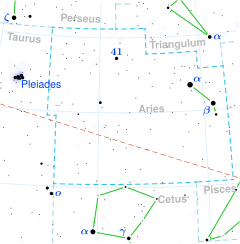Eta Arietis, Latinized from η Arietis, is the Bayer designation for a star in the northern constellation of Aries. It is dimly visible to the naked eye with an apparent visual magnitude of 5.231.[2] With an annual parallax shift of 33.34 mas,[1] the distance to this star is approximately 97.8 light-years (30.0 parsecs). It is drifting further away with a radial velocity of +4.5 km/s.[2]
| Observation data Epoch J2000 Equinox J2000 | |
|---|---|
| Constellation | Aries |
| Right ascension | 02h 12m 48.08568s[1] |
| Declination | +21° 12′ 39.5776″[1] |
| Apparent magnitude (V) | 5.231[2] |
| Characteristics | |
| Spectral type | F5 V[3] |
| U−B color index | –0.04[4] |
| B−V color index | +0.44[4] |
| Astrometry | |
| Radial velocity (Rv) | +4.5[2] km/s |
| Proper motion (μ) | RA: +163.917[1] mas/yr Dec.: +5.000[1] mas/yr |
| Parallax (π) | 33.3383 ± 0.1196 mas[1] |
| Distance | 97.8 ± 0.4 ly (30.0 ± 0.1 pc) |
| Absolute magnitude (MV) | +2.93[2] |
| Details | |
| Mass | 1.21[5] M☉ |
| Radius | 1.823[6] R☉ |
| Luminosity | 6.0[6] L☉ |
| Surface gravity (log g) | 4.01[3] cgs |
| Temperature | 6,700[6] K |
| Metallicity [Fe/H] | –0.35[3] dex |
| Rotational velocity (v sin i) | 9[7] km/s |
| Age | 2.6 Gyr[2] 3.98[5] Gyr |
| Other designations | |
| Database references | |
| SIMBAD | data |
This is an F-type main sequence star with a stellar classification of F5 V.[3] It is younger than the Sun at an age of about 2.6 billion years.[2] The effective temperature of the outer atmosphere is 6,380 K,[3] giving it the yellow-white-hued glow of an F-type star. Eta Arietis was examined using the HARPS instrument for radial velocity variations that may be caused by an orbiting companion, but no signal was detected.[8] Nor has an infrared excess been detected using the Spitzer Space Telescope, which might otherwise indicate the presence of circumstellar gas or dust.[9]
